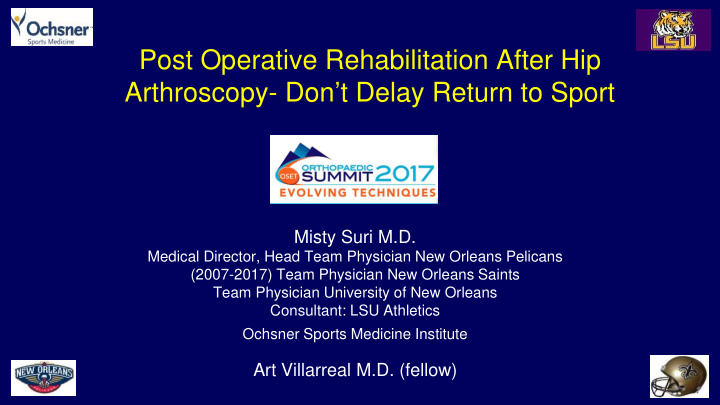



Post Operative Rehabilitation After Hip Arthroscopy- Don’t Delay Return to Sport Misty Suri M.D. Medical Director, Head Team Physician New Orleans Pelicans (2007-2017) Team Physician New Orleans Saints Team Physician University of New Orleans Consultant: LSU Athletics Ochsner Sports Medicine Institute Art Villarreal M.D. (fellow)
with permisssion
with permisssion
with permisssion
• 44 hips among intercollegiate or professional baseball players – Return to play 42/44 (95%) at 4.3 months (3-8 mo) – Rehab: • debridement- WBAT w/ crutches x 1 wk • femoroplasty- WBAT w/ crutches x 4 wks • labral repair- 50% WB x 4 wks; limit ER & max flexion • microfracture- protected WB x 8 wks • “structured rehab” x 12 wks followed by functional progression toward return to sport
• 20 male professional golfers (27 hips) – 11 labral repair, 16 labral debridement, 4 microfx – 100% return to play – avg. return to sport 4.7 mos (1 mo - 2 yrs)
• 28 NHL players – 100% return to skating/hockey drills • return 3.8 mos (1-5 mo) – Rehab: 20 lbs WB & 4hrs CPM x 2 wks (8wks for microfx) • rotation precaution boots 14-21 days • PT progression PROM, AROM then strengthening • IR followed by ER • passive hip pendulums for adhesion prevention
• 66 patients – 49 recreational athletes, 17 high level amateurs (high school/college) – return to sport: rec 94%, amateur 88% – cleared to return to play: 4-6 mos – self reported return to play: • amateur: 9 +/- 5.3 months • rec: 10 +/- 5.3 months
• 51 pts w/ FAI – 48 (94%) returned to running at 8.5 +/- 4.2 mo • Pts discontinuing running > 8mo prior to surgery with longer return to running – 10.6 +/- 4.2 mo vs. 7.6 +/- 4.1 mo p = 0.01 • Rehab – 20 lb WB x 2 wks – elliptical beginning wk 6 w/ functional exercises as tol – running w/ antigravity treadmill at 12 weeks
• 31 ISHA surgeons with published rehab protocol online – Bracing 17/31 x median 2 wks (1-6 wks) – Ice 18/31 x median 2.5 wks (1-8 wks) – CPM 16/31 x median 4 wks (2-4 wks) – 29/31 specify WB status • NWB 1/29 • TDWB 4/29 • PWB 20/29 • WBAT 4/29 – Return to running specified by 20/31; median 12 wks (6-19 wks) – Return to sport specified by 13/31; median 15.5 wks (9-23 wks)
• Survey of 27 high volume hip arthroscopists Recommended return to sport: Recommended return to sport criteria Able to perform single leg squat 5 (19%) 6-12 weeks 2 (7.5%) Able to perform lateral agility drills 5 (19%) 12-16 weeks 10 (37%) Able to perform single leg squat without pain 15 (56%) Able to perform lateral agility drills without pain 19 (70%) 16-20 weeks 9 (33%) Able to run without pain 19 (70%) Able to jump without pain 16 (59%) 20-24 weeks 4 (15%) Able to reproduce all motions involved in sport without pain 23 (85%) No response 2 (7.5%) Minimal cartilage damage seen at arthroscopy 1 (4%)
Vail Sport Test Garrison et al. The reliability of the Vail sport test as a measure of physical performance following ACL Reconstruction. IJSPT. 2012; 7 (1) 20 – 30. “Functional tool that is reliable in assessing performance in RTS phase of rehab. When used as a component in a battery of outcome measures it may allow for effective clinician evaluation.”
Other considerations: Return to sport ratios post injury Thorborg, K. et al. Hip adduction and abduction strength profiles in elite soccer players: implications for clinical evaluation of hip adductor muscle recovery after injury. • An ipsilateral hip adduction/abduction strength ratio of more than 90%, has been suggested to clinically represent adequate strength recovery with groin injury. Thorborg K, et al. Eccentric hip adduction and abduction strength in elite soccer players and matched controls: a cross sectional study Br J Sports Med. 2011 . • Lower extremity strength deficits of less than 10% on the injured side, compared to the uninjured side, have been suggested as the clinical milestone before returning to sports following injury.
with permisssion
Recommend
More recommend